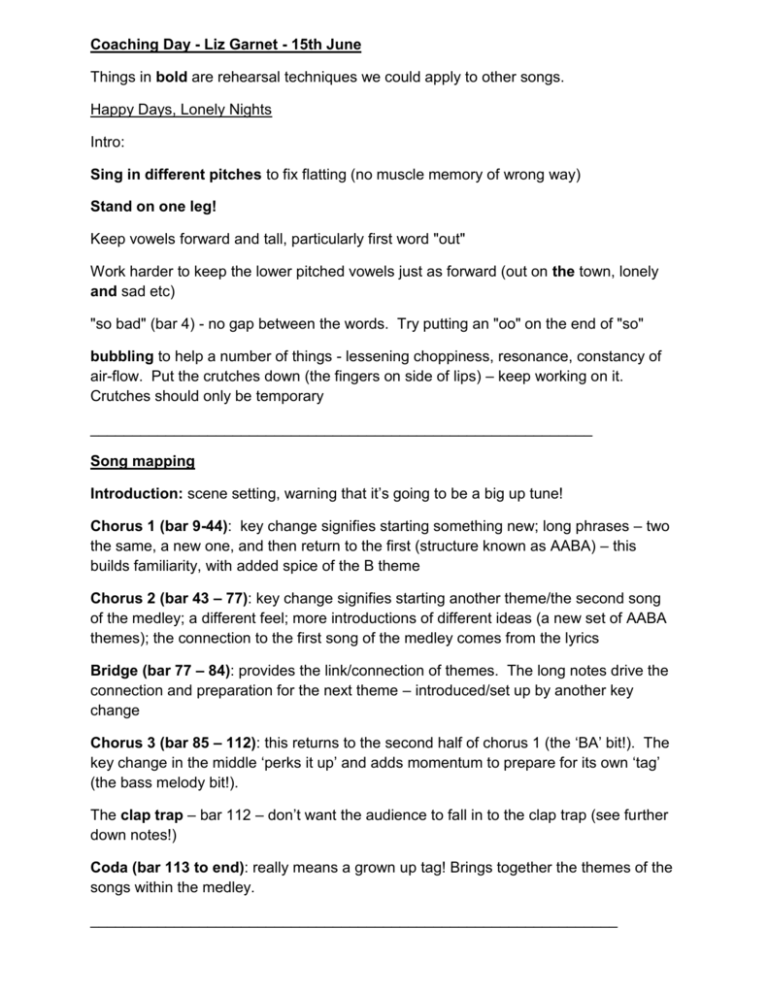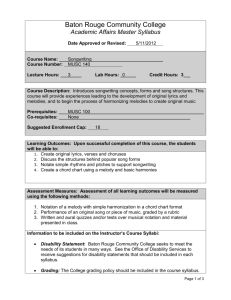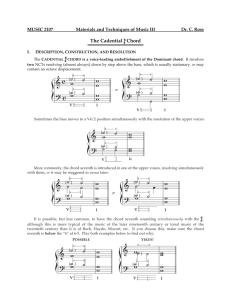Coaching Day - Liz Garnet - 15th June Things in bold are rehearsal
advertisement

Coaching Day - Liz Garnet - 15th June Things in bold are rehearsal techniques we could apply to other songs. Happy Days, Lonely Nights Intro: Sing in different pitches to fix flatting (no muscle memory of wrong way) Stand on one leg! Keep vowels forward and tall, particularly first word "out" Work harder to keep the lower pitched vowels just as forward (out on the town, lonely and sad etc) "so bad" (bar 4) - no gap between the words. Try putting an "oo" on the end of "so" bubbling to help a number of things - lessening choppiness, resonance, constancy of air-flow. Put the crutches down (the fingers on side of lips) – keep working on it. Crutches should only be temporary ____________________________________________________________ Song mapping Introduction: scene setting, warning that it’s going to be a big up tune! Chorus 1 (bar 9-44): key change signifies starting something new; long phrases – two the same, a new one, and then return to the first (structure known as AABA) – this builds familiarity, with added spice of the B theme Chorus 2 (bar 43 – 77): key change signifies starting another theme/the second song of the medley; a different feel; more introductions of different ideas (a new set of AABA themes); the connection to the first song of the medley comes from the lyrics Bridge (bar 77 – 84): provides the link/connection of themes. The long notes drive the connection and preparation for the next theme – introduced/set up by another key change Chorus 3 (bar 85 – 112): this returns to the second half of chorus 1 (the ‘BA’ bit!). The key change in the middle ‘perks it up’ and adds momentum to prepare for its own ‘tag’ (the bass melody bit!). The clap trap – bar 112 – don’t want the audience to fall in to the clap trap (see further down notes!) Coda (bar 113 to end): really means a grown up tag! Brings together the themes of the songs within the medley. _______________________________________________________________ Finger click on backbeat/offbeat to embed rhythm for this type of song – a ‘sling’ beat. This also helps to identify where it slows down Tempo issues – often caused by breathing too late and/or inefficiently, so ensure all breaths are planned and prepared for Bridge: the basses are like the huge engine of a Jaguar car, purring away underneath, being revved up a little on each long held note ready to spring forward. The leads/tenors/baris are like the little razzy wind up cars on the top, being pulled back and released to zoom forward in little bursts of energy Bar 62 – don’t ‘throw away’ the move or the sound will follow – ensure the move is a positive one Bar 80 - don't breathe after "had" for improved swooshythroughiness. Use the breath to add pulse into the rhythm Bar 85 – needs to be more lascivious (and you all did it so well!) Bar 91 "just can't" higher note - frustrated, emotional oomphiness. This creates the "dammit chord" – the really jangly pivotal chord marking a change from where you’ve been to what’s coming next Bar 92 end "forget" with a clear "t" then breathe in time and propel forward. Breathing points must add the spritz – they must not be blank spaces. Everything needs something of purpose – so when breathing, ensure eyes, face and posture maintains and develops personal and group presence There are lots of dirty notes in this song (although not for baritones) e.g. needing you (leads) – dirty notes need to be fuffed to have the right impact How Deep is the Ocean (can't find music so no bar references I'm afraid) Song map involved 2 arches with the peaks at "sky-how" and "star -and if" Be prepared If you remove the tag, the musical climax would come somewhere else (the first ‘sky’ and it would be on a different chord like the original song) so bar 48 becomes a false ending. Start more mysteriously Don't dip out wherever you’re not singing (for example whilst leads post in bar 3, or wherever you breath, or anyone else has a pick up). Need even more presence. Chorus (starts bar 17): Bass pick up - softer, more intimate (then rest of us follow); filled with awe (in both sense and sound) Bar 20 "lie" - more baritone (to add caffeine/put the buzz in the chord!) - will help chorus build in next phrase Bar 24 – baritone swipe needs to build not retreat (with support from others) – and wherever else there is a swipe Clearer planning needed within each phrase to ensure they always build and arrive at their destination, even when the gradient is steeper! Bar 25 "how many times a day" - we prepared by added outstretched arms outstretched to start phrase louder (and again for "and if") Bar 28 to 29 – affirm the connection between the two phrases before the emotive release Bar 36 "where you are" – baritones are mega important! Bar 48 "how high is the sky" – this is the false ending (deceptive cadence) - not what audience is expecting - dramatic effect – uses melancholy and converts to drama, reaching out to the audience (i.e. louder!) Bar 49 – really important Chinese 7th on "sky" (the second chord – after bass and lead have moved) (and a quick one in bar 38 "journey" first syllable) - needs balancing differently (listen to the tenors as it’s cantilevered from the top down for this one). Ideas for practising this type of seventh chord – everyone sings all four notes in sequence, peel off like a bell chord. Leads need to keep enjoying hearing the tenor note to balance it out, not overpower it. Some "you"s - not getting to the vowel quick enough Putting more "dome" into the sound - the dome comes through the back and top of the head, with the teeth like the tiles, and lips as curtains (Dome and beak). All of this lifts through the support from the ‘box’ mechanism (your breathing equipment, starting much lower in the body). Duetting gave opportunity for others to practise listening! ________________________________________________________________ Wrap up reminders at the end of the day Transition between volumes important – no startling moments – make the transition across the phrasing Listening more Singing through the smaller words ensuring the lower-pitched words don’t disappear/go backwards in the sound Flow through critical (ie forward motion) – have awareness of the value of vowels and the continuity of voice Hearing why the music does what it does – ie why the arranger might make a decision for a certain chord, key change etc There is nothing you can’t do – just sometimes need more practice ‘chaptering’ the song helps to get your head around it Have a visual thought to support what you want to achieve (ie the ‘dammit’ chord, or the arms flung up) Being prepared before EVERYTHING – it’s not just about the breath Everyone was challenged to think about what as individuals we can do different to embed, reinforce and consistently deliver. Everyone was asked to think about their own targets and write them down before forgetting!











